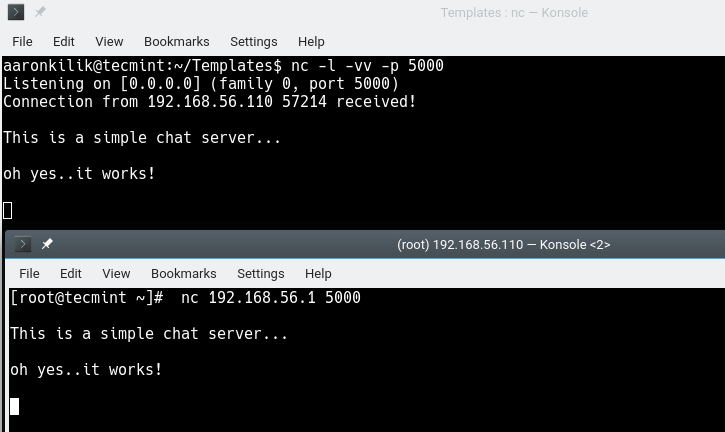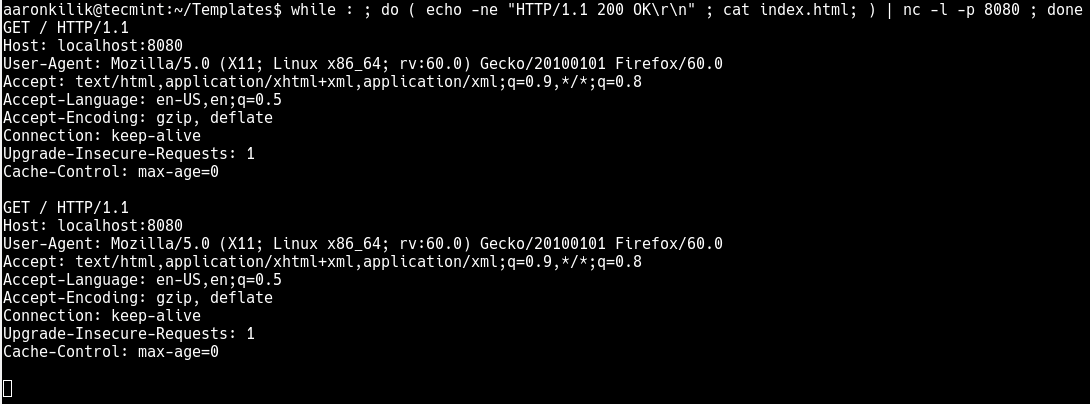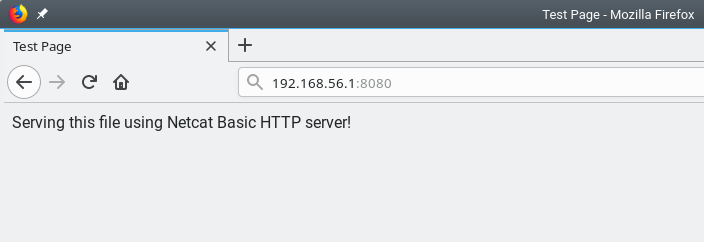How Is Netcat Used With Dd To Aquire Data
Netcat (or nc in short) is a elementary yet powerful networking command-line tool used for performing whatever operation in Linux related to TCP, UDP, or UNIX-domain sockets.
Netcat tin can exist used for port scanning, port redirection, as a port listener (for incoming connections); it can also exist used to open up remote connections and so many other things. Too, you can use information technology as a backdoor to gain access to a target server.
In this commodity, nosotros will explicate Netcat usage commands with examples.
How to Install and Utilise Netcat in Linux
To install the netcat package on your system, utilise the default packet manager for your Linux distribution.
$ yum install nc [On CentOS/RHEL] $ dnf install nc [On Fedora 22+ and RHEL eight] $ sudo apt-get install Netcat [On Debian/Ubuntu]
One time netcat package installed, you tin proceed further to learn the usage of netcat control in the post-obit examples.
Port Scanning
Netcat can be used for port scanning: to know which ports are open and running services on a target machine. It tin can scan a single or multiple or a range of open ports.
Here is an example, the -z option sets nc to just scan for listening daemons, without really sending any data to them. The -v pick enables verbose style and -w specifies a timeout for connection that can non be established.
$ nc -v -westward two z 192.168.56.i 22 #scan a unmarried port OR $ nc -v -w 2 z 192.168.56.i 22 80 #scan multiple ports OR $ nc -five -w 2 z 192.168.56.1 xx-25 #scan range of ports

Transfer Files Between Linux Servers
Netcat allows you to transfer files betwixt 2 Linux computers or servers and both these systems must have nc installed.
For instance, to copy an ISO image file from ane computer to another and monitor the transfer progress (using the pv utility), run the following command on the sender/server calculator (where the ISO file exists).
This volition run nc in listening mode (-l flag) on port 3000.
$ tar -zcf - debian-x.0.0-amd64-xfce-CD-1.iso | pv | nc -l -p 3000 -q 5
And on the receiver/customer computer, run the following command to obtain the file.
$ nc 192.168.ane.4 3000 | pv | tar -zxf -

Create a Command Line Chat Server
Y'all can also employ Netcat to create a simple command-line messaging server instantly. Equally in the previous usage example, nc must be installed on both systems used for the chat room.
On one system, run the following command to create the chat server listening on port 5000.
$ nc -l -vv -p 5000
On the other system, run the following command to launch a conversation session to a machine where the messaging server is running.
$ nc 192.168.56.i 5000

Create a Bones Web Server
Wit the -l pick of nc command used to create a basic, insecure spider web server to serve static web files for learning purposes. To demonstrate this, create a .html file every bit shown.
$ vim alphabetize.html
Add the following HTML lines in the file.
<html> <caput> <title>Test Page</title> </head> <body> <p>Serving this file using Netcat Basic HTTP server!</p> </body> </html>
Relieve changes in the file and leave.
Then serve the higher up file over HTTP by running the post-obit command, which volition enables the HTTP server to run continuously.
$ while : ; practice ( echo -ne "HTTP/1.1 200 OK\r\n" ; cat index.html; ) | nc -l -p 8080 ; done

Then open a web browser and can access the content using the following accost.
http://localhost:8080 OR http://SERVER_IP:8080

Annotation that you can to stop the Netcat HTTP server by pressing [Ctrl+ C].
Troubleshoot Linux Server Connexion
Some other useful usage of Netcat is to troubleshoot server connection issues. Here, you can use Netcat to verify what information a server is sending in response to commands issued by the client.
The following command retrieves the home page of example.com.
$ printf "GET / HTTP/1.0\r\n\r\due north" | nc text.example.com 80
The output of the above command includes the headers sent past the spider web-server which can be used for troubleshooting purposes.
Find a Service Running on Port
You tin can also use Netcat to obtain port banners. In this example, information technology volition tell you what service is running behind a certain port. For instance to know what type of service is running behind port 22 on a specific server, run the post-obit command (supersede 192.168.56.110 with the target server'southward IP address). The -north flag ways to disable DNS or service lookups.
$ nc -v -northward 192.168.56.110 80

Create a Stream Sockets
Netcat also supports cosmos of UNIX-domain stream sockets. The post-obit control will create and listen on a UNIX-domain stream socket.
$ nc -lU /var/tmp/mysocket & $ ss -lpn | grep "/var/tmp/"

Create a Backstairs
Y'all can as well run Netcat as a backdoor. Yet, this calls for more work. If Netcat is installed on a target server, you tin use it to create a backstairs, to go a remote command prompt.
To deed a backstairs you demand Netcat to mind on a chosen port (e.g port 3001) on the target server and then you can connect to this port from your motorcar equally follows.
This is the command intended to run on the remote server where the -d option disables reading from stdin, and -e specifies the command to run on the target organisation.
$ nc -50 -p 3001 -d -due east cmd.exe
Last but not least, Netcat can be used as a proxy for unlike services/protocols including HTTP, SSH, and many more. For more information, encounter its man page.
$ man nc
In this article, nosotros have explained viii practical Netcat control usage examples. If you know any other applied use case(s), share with usa via the feedback form below. You lot tin can ask a question as well.
If You Appreciate What We Exercise Here On TecMint, Yous Should Consider:
TecMint is the fastest growing and most trusted customs site for whatsoever kind of Linux Articles, Guides and Books on the web. Millions of people visit TecMint! to search or scan the thousands of published articles available FREELY to all.
If you like what you are reading, please consider buying u.s.a. a coffee ( or 2 ) as a token of appreciation.

Nosotros are thankful for your never ending support.
How Is Netcat Used With Dd To Aquire Data,
Source: https://www.tecmint.com/netcat-nc-command-examples/
Posted by: monarrezyousses.blogspot.com


0 Response to "How Is Netcat Used With Dd To Aquire Data"
Post a Comment